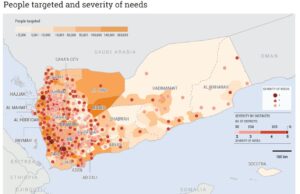by Ambra Visentin
After nearly a decade of war, the humanitarian situation in Yemen is collapsing. Fighting between government forces, led by Rashad al Alimi and backed by a Saudi-led coalition, and Houthi rebels, also known as Ansar Allah, who have held the capital Sanaa since 2014 and control the most populous part of the country, has left 18.2 million Yemenis in need of life-saving aid and protection. Acute food insecurity affects 17.6 million people. To address this emergency, the UN and its partners have appealed for more humanitarian aid: $2.7 billion is needed.
The Red Sea attacks and the new war
Since the outbreak of the war in Gaza in October, the Houthis have opened a second front in the war between pro-Palestinian and pro-Israeli sides in the Red Sea by attacking US ships. In response, the international coalition led by the US and UK bombed positions in Yemen on 11 January.
The Houthis are equipped with a diverse arsenal of anti-ship weapons, which some experts believe is the result of a steady build-up of Houthi capabilities by Iran over the past few years. Tehran may be attempting to transfer its strategy of blocking shipping lanes in the Persian Gulf to the Red Sea.
Yesterday, 6 February, the Houthis’ military spokesman, Brigadier General Yahya Saree, confirmed the firing of missiles at two ships west of the Yemeni port of Hodeidah: the Morning Tide, a Barbados-flagged, British-owned cargo ship, and the Star Nasia, an American ship flying the flag of the Marshall Islands.
The humanitarian crisis
Aid workers report that child mortality in Yemen improved slightly in 2023 after years of sustained aid. However, the country has some of the highest rates of malnutrition ever recorded.
Nearly half of all children under five suffer from moderate to severe stunting – stunted growth and development due to poor nutrition – and the situation is worsening.
In addition, 12.4 million people lack adequate access to safe drinking water, increasing the risk of infectious diseases, while more than 4.5 million school-age children are out of school.
An estimated 4.5 million people are currently displaced across Yemen, a third of whom have been uprooted more than once.
The call for more humanitarian aid
Despite the challenges, humanitarian organisations reached an average of over 8.6 million people per month in 2023. Inadequate funding and access constraints have led humanitarian actors to adapt their response. “Yemen is facing a critical juncture and has a unique opportunity to take a decisive step away from the humanitarian crisis by addressing the drivers of need,” said Peter Hawkins, interim UN Resident and Humanitarian Coordinator in the country. “While regional conflict dynamics have introduced additional risks, the humanitarian community remains committed to stay and deliver.”

The 2024 Humanitarian Response Plan (HRP), consolidated by UNOCHA (the Office for the Coordination of Humanitarian Affairs) on behalf of the Humanitarian Country Team and partners, targets 11.2 million vulnerable people. It aims to improve prioritisation and accountability at the local level. Alignment with the 1.3 billion United Nations Sustainable Development Cooperation Framework (UNSDCF) for Yemen 2022-2025 aims to promote integration and synergies between humanitarian and development efforts. To implement these plans, humanitarian actors are seeking USD 2.7 billion.
“We must not turn our backs on the people of Yemen. I am appealing to donors for their continued and urgent support to save lives, build resilience, and also to fund sustainable interventions,” Mr. Hawkins said.
Cover image by Mohammed al-wafi on Shutterstock: displaces people living on the slopes of the mountains receive humanitarian aid
Related articles:
























